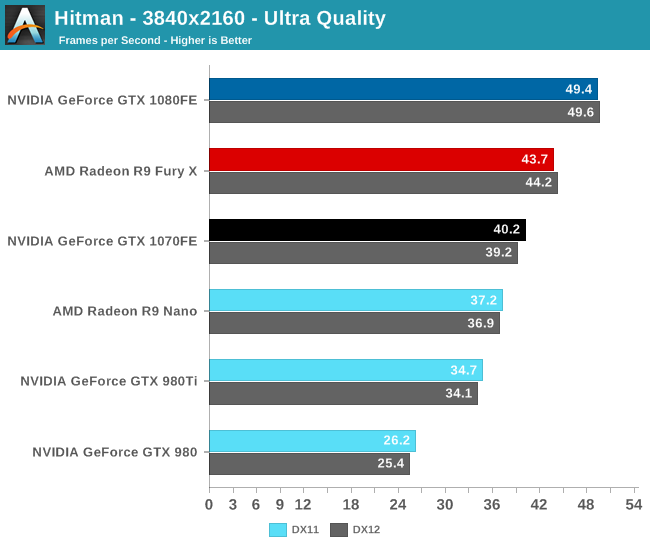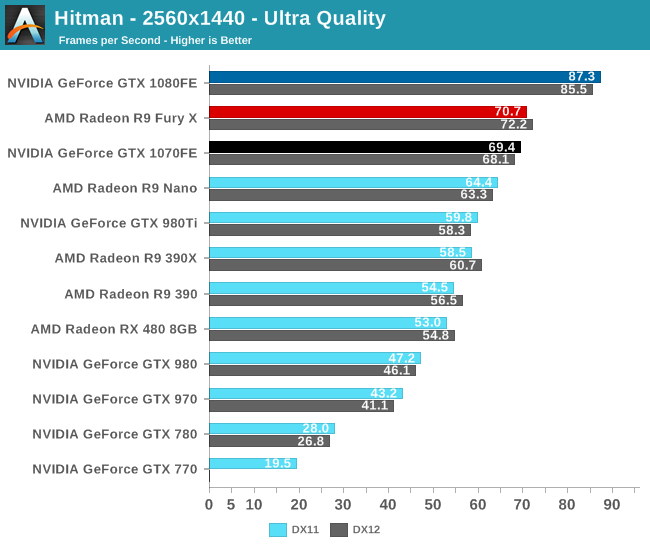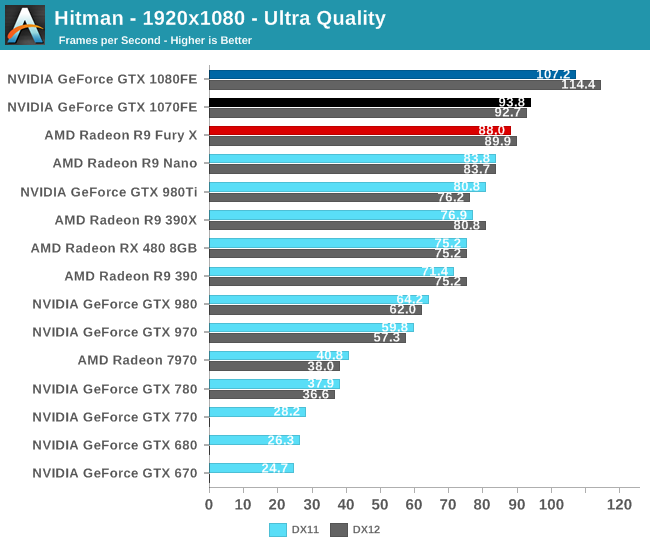The NVIDIA GeForce GTX 1080 & GTX 1070 Founders Editions Review: Kicking Off the FinFET Generation
by Ryan Smith on July 20, 2016 8:45 AM ESTHitman
The final game in our 2016 benchmark suite is the 2016 edition of Hitman, the latest title in the stealth-action franchise. The game offers two rendering paths: DirectX 11 and DirectX 12, with the latter being the case of DirectX 12 being added after the fact. As with past Hitman games, the latest proves to have a good mix of scenery and high model counts to stress modern video cards.



Because Hitman supports both DX11 and DX12, for the moment we’ve gone ahead and benchmarked it with both. In practice the performance impact of DX12 is very mixed; NVIDIA cards prior to Pascal lose performance and Pascal cards can either gain or lose performance. AMD cards on the other hand tend to gain performance. The image quality is the same with both renderers, so it’s simply a matter of picking the render path that produces the best performance for a given card.
In any case, the GTX 1080 continues to top the charts here. 60fps still isn’t attainable at 4K, but it can deliver a reasonably playable 49fps. Alternatively, at 1440p it does better than 85fps. Meanwhile the GTX 1070 isn’t a great option at 4K, but at 1440p it can easily stay north of 60fps, delivering 69.4fps.
Thanks in part to the DX12 code path, this is another game where the GTX 1070 performs as expected versus GTX 1080, but still can’t hold on to second place. Rather the Radeon Fury X takes second place at all but 1080p.
Looking at our generational comparisons one last time, this final game has the Pascal cards performing better than expected. At 1440p and above, the GTX 1080 hits 86% better performance than the GTX 980 under DirectX 11, and the GTX 1070 bests the GTX 970 by an average of 63% in the same circumstances. As best as I can tell, there is just something about the Pascal cards that is slightly more in tune with this game than was the Maxwell 2 cards, leading to the performance we’re seeing here. Otherwise the gap between the GTX 1080 and GTX 1070 is pretty typical at about 25% at the higher resolutions.
Finally, in our last time checking in on the GTX 680, the GTX 1080 offers a commanding performance improvement. GTX 1080 is 4.1x faster than GTX 680 under DirectX 11, reinforcing just how much progress NVIDIA had made in 4 years and a single full manufacturing node upgrade.










200 Comments
View All Comments
Ryan Smith - Wednesday, July 20, 2016 - link
Thanks.Eden-K121D - Wednesday, July 20, 2016 - link
Finally the GTX 1080 reviewguidryp - Wednesday, July 20, 2016 - link
This echoes what I have been saying about this generation. It is really all about clock speed increases. IPC is essentially the same.This is where AMD lost out. Possibly in part the issue was going with GloFo instead of TSMC like NVidia.
Maybe AMD will move Vega to TSMC...
nathanddrews - Wednesday, July 20, 2016 - link
Curious... how did AMD lose out? Have you seen Vega benchmarks?TheinsanegamerN - Wednesday, July 20, 2016 - link
its all about clock speed for Nvidia, but not for AMD. AMD focused more on ICP, according to them.tarqsharq - Wednesday, July 20, 2016 - link
It feels a lot like the P4 vs Athlon XP days almost.stereopticon - Wednesday, July 20, 2016 - link
My favorite era of being a nerd!!! Poppin' opterons into s939 and pumpin the OC the athlon FX levels for a fraction of the price all while stompin' on pentium. It was a good (although expensive) time to a be a nerd... Besides paying 100 dollars for 1gb of DDR500. 6800gs budget friendly cards, and ATi x1800/1900 super beasts.. how i miss the dayseddman - Thursday, July 21, 2016 - link
Not really. Pascal has pretty much the same IPC as Maxwell and its performance increases accordingly with the clockspeed.Pentium 4, on the other hand, had a terrible IPC compared to Athlon and even Pentium 3 and even jacking its clockspeed to the sky didn't help it.
guidryp - Wednesday, July 20, 2016 - link
No one really improved IPC of their units.AMD was instead forced increase the unit count and chip size for 480 is bigger than the 1060 chip, and is using a larger bus. Both increase the chip cost.
AMD loses because they are selling a more expensive chip for less money. That squeezes their unit profit on both ends.
retrospooty - Wednesday, July 20, 2016 - link
"This echoes what I have been saying about this generation. It is really all about clock speed increases. IPC is essentially the same."- This is a good thing. Stuck on 28nm for 4 years, moving to 16nm is exactly what Nvidias architecture needed.